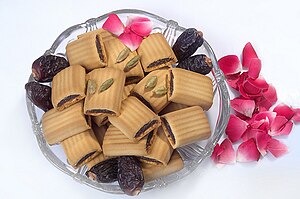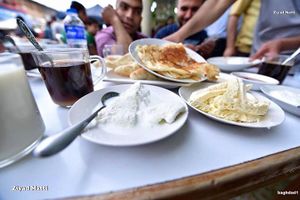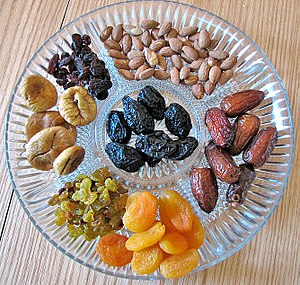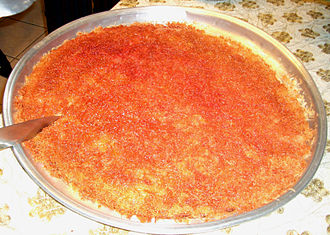Chaldean cuisine
Chaldean cuisine or Mesopotamian cuisine has a long history going back some 10,000 years – to the Sumerians, Babylonians Chaldeans and Ancient Persians.[1] Tablets found in ancient ruins in Iraq show recipes prepared in the temples during religious festivals – the first cookbooks in the world.[1] Ancient Iraq, or Mesopotamia, was home to a sophisticated and highly advanced civilization, in all fields of knowledge, including the culinary arts.[1] However, it was in the Islamic Golden Age when Baghdad was the capital of the Abbasid Caliphate (750–1258) that the Iraqi kitchen reached its zenith.[1] Today, the cuisine of Iraq reflects this rich inheritance as well as strong influences from the culinary traditions of neighbouring Persia, Turkey and the Syria region area.[1]
Meals begin with appetizers and salads – known as Mezza. Some dishes include Kebab (often marinated with garlic, lemon and spices, then grilled), Gauss (grilled meat sandwich wrap, similar to Döner kebab), Bamieh (lamb, okra and tomato stew), Quzi (lamb with rice, almonds, raisins and spices), Falafel (fried chickpea patties served with amba and salad in pita), Kubbah (minced meat ground with bulghur wheat or rice and spices), Masgûf (grilled fish with pepper and tamarind), and Maqluba (a rice, lamb, tomato and aubergine dish). Stuffed vegetable dishes such as Dolma and Mahshi are also popular.[2]
Contemporary Iraq reflects the same natural division as ancient Mesopotamia,[3] which consisted of Mesopotamia in the arid northern uplands and Babylonia or Chaldea in the southern alluvial plain.[3] Al-Jazira (the ancient Chaldea) grows wheat and crops requiring winter chill such as apples and stone fruits.[3] Al-Irāq (Iraq proper, the ancient Babylonia) grows rice and barley, citrus fruits, and is responsible for Iraq's position as the world's largest producer of dates.[3]
Contents
[hide]History
Archaeologists have found evidence from excavations at Jarmo in northeastern Iraq,[4] that pistachio nuts were a common food as early as 6750 BC.[4]
Among the ancient texts discovered in Iraq is a Sumerian-Akkadian bilingual dictionary,[5] recorded in cuneiform script on 24 stone tablets about 1900 BC.[5] It lists terms in the two ancient Iraqi languages for over 800 different items of food and drink.[5] Included are 20 different kinds of cheese, over 100 varieties of soup and 300 types of bread – each with different ingredients, filling, shape or size.[5]
One of three excavated cuneiform clay tablets written in 1700 BC in Babylon,[2] 50 miles south of present-day Baghdad, deals with 24 recipes for stew cooked with meat and vegetables,[2] enhanced and seasoned with leeks, onion, garlic, and spices and herbs like cassia, cumin, coriander, mint, and dill.[2] Stew has remained a mainstay in the cuisine.[2] Extant medieval Iraqi recipes and modern Iraqi cuisine attest to this.[2]
Chaldean Cuisine
Ingredients
Some characteristic ingredients of Chaldean cuisine include:
- Vegetables such as aubergine, tomato, okra, onion, potato, courgette, spinach, leeks, artichokes, garlic, peppers and chilli.
- Cereals such as rice, bulghur wheat and barley.
- Pulses and legumes such as lentils, chickpeas, green beans, green grams, and cannellini.
- Fruits such as olives, dates, raisins, apricots, plums, figs, grapes, melons, pomegranate, apples, cherries, quince, and citrus fruits; orange, lemon and lime.
- Cheeses such as gubta, feta and halloumi.
- Herbs and spices such as cinnamon, cardamom, coriander, fenugreek, cumin, oregano, mint, thyme, saffron, dried lime, cassia, dill, turmeric, baharat, advieh, sumac and za'atar.
- Nuts and seeds such as sesame, pistachios, almonds, walnuts, hazelnuts and pine nuts.
Other Iraqi culinary essentials include olive oil, sesame oil, tamarind, vermicelli, tahini, honey, date syrup, yogurt and rose water. Lamb is the favourite meat, but chicken, beef, and fish are also eaten. Most dishes are served with rice - usually timman anbar, a yellowish, very aromatic, long-grain rice grown in the provinces of Anbar and Qadisiyyah.[6] Bulghur wheat is used in many dishes, having been a staple in the country since the days of the Chaldeans.[1] Flatbread is a staple that is served, with a variety of dips, cheeses, olives, and jams, at every meal.
Mezza
Mezza is a selection of appetizers or small dishes often served with beverage, like anise-flavored liqueurs such as arak, ouzo, raki or different wines, similar to the tapas of Spain or finger food.
- Baytinijan Maqli, a dish often served cold, consisting of fried aubergine with tahini sauce, lettuce, parsley and tomatoes, garnished with sumac and served on pita bread or sliced bread, often grilled or toasted. Variations include bell peppers, or a garlic lemon vinaigrette.
- Fattoush, a salad made from several garden vegetables and toasted or fried pieces of pita bread.
- Tabbouleh, a salad dish, often used as part of a mezze. Its primary ingredients are finely chopped parsley, bulgur, mint, tomato, scallion, and other herbs with lemon juice, olive oil and various seasonings, generally including black pepper and sometimes cinnamon and allspice.
- Turshi, pickled vegetables in the cuisine of many Balkan and Middle East countries. It is a traditional appetizer, meze for rakı, ouzo, tsipouro and rakia.
- Arab salad
Dips
- Baba ghanoush, a dish of baked aubergine mashed and mixed with various seasonings.
- Hummus, a dip or spread made from cooked, mashed chickpeas, blended with tahini, olive oil, lemon juice, salt and garlic.
- Muhammara, a hot pepper dip originally from Aleppo, Syria.
- Tzatziki, an appetizer of Ottoman cuisine origin, also used as a sauce for souvlaki and gyros. Tzatziki is made of strained yogurt (usually sheep's-milk or goat's-milk in Greece and Turkey) with cucumbers, garlic, salt, usually olive oil, pepper, dill, sometimes lemon juice and parsley, or mint added. The cucumbers are either pureed and strained, or seeded and finely diced. Olive oil, olives, and herbs are often used as garnishes.
Soups and stews
Various stews served over rice form a major part of Iraqi cuisine. A feature shared with Persian cuisine (see Khoresht).
- Abgoosht
- Fasoulia, a soup of dry white beans, olive oil, and vegetables.
- Harissa, a dish similar to keşkek that is a kind of homogeneous porridge made of previously stewed and boned chicken and coarsely ground soaked wheat.
- Lentil soup
- Margat Bamia or simply Bamia, a stew made with okra and lamb or beef cubes and in a tomato sauce.[7]
- Fesenjān, a thick, tart stew made from pomegranate syrup and ground walnuts (see bazha). It is traditionally made with poultry (duck or chicken)
- Kebabs, a dish consisting of grilled or broiled meats on a skewer or stick.[8] The most common kebabs include lamb and beef, although others use chicken or fish.
- Qeema, a minced meat, tomato and chickpea stew, served with rice. Traditionally prepared at the annual Ashura commemorations in southern Iraq. The name qeema is an ancient Akkadian word meaning 'finely chopped'.[9]
- Maqluba, an upside-down rice and aubergine casserole, hence the name which is literally translated as "upside-down". It is sometimes made with fried cauliflower instead of aubergine and usually includes meat - often braised lamb.[10]
- Masgouf, a traditional Mesopotamian dish made with fish from the Tigris.[8][11] It is an open cut freshwater fish roasted for hours after being marinated with olive oil, salt, curcuma and tamarind while keeping the skin on. Traditional garnishes for the masgouf include lime, chopped onions and tomatoes, as well as the clay-oven flatbreads common to Iraq and much of the Middle East.
- Margat Baytinijan, an aubergine based dish of the Balkans and the Middle East. All versions are based primarily on sautéed aubergine and tomato, usually with minced meat.
- Pomegranate soup, called Shorbat Rumman in Iraq. It is made from pomegranate juice and seeds, yellow split peas, ground beef, mint leaves, spices, and other ingredients.[12]
- Shorbat Rumman, a soup made from pomegranate juice and seeds, yellow split peas, mint leaves, spices, and other ingredients.
- Quzi, stuffed roasted lamb.[8][11]
- Tashrib, a soup made with either lamb or chicken with or without tomatoes eaten with Iraqi nan. The bread is broken up into pieces and the soup is poured over in a big bowl.
- Tahdig
- Tepsi Baytinijan, an Iraqi casserole. The main ingredient of the dish is aubergine, which are sliced and fried before placing in a baking dish, accompanied with chunks of either lamb/beef/veal or meatballs, tomatoes, onions and garlic. On top of the aubergine, potato slices are placed on top of the mixture, and the dish is baked. Like many other Iraqi dishes it is usually served with rice, along with salad and pickles.
Dumplings and meatballs
- Dolma, a family of stuffed vegetable dishes. The grape-leaf dolma is common. Zucchini, aubergine, tomato and pepper are commonly used as fillings. The stuffing may or may not include meat.[13]
- Falafel, a fried ball or patty made from spiced chickpeas and/or fava beans. Originally from Egypt, falafel is a form of fast food in the Middle East, where it is also served as a mezze.
- Kubba, a dish made of burghul, chopped meat, and spices. The best-known variety is a torpedo-shaped burghul shell stuffed with chopped meat and fried. Other varieties are baked, poached, or even served raw as famously done by the Lebanese. They may be shaped into balls, patties, or flat.[12]
- Kofta, a family of meatball or meatloaf dishes in Middle Eastern, Indian, and Balkan cuisines. In the simplest form, koftas consist of balls of minced or ground meat — usually beef or lamb — mixed with spices and/or onions. Vegetarian varieties include lauki kofta, shahi aloo kofta, and malai kofta.
- Manti, a type of dumpling stuffed with meat and vegetables.
- Sarma
- Samosa, a small fried or baked pasty, which may be either half-moon shaped or triangular.
Processed meat
- Pastırma, a highly seasoned, air-dried cured beef in the cuisines of the former Ottoman countries.
- Sujuk, a dry, spicy sausage eaten from the Balkans to the Middle East and Central Asia.
Rice dishes
Long-grain rice is a staple in Iraqi cookery.[8][11] The Iraqi word for rice, timman, is unique to Iraq and is of Akkadian origin.
Iraqi rice cooking is similar to the method used for Persian chelow,[6] a multistep process intended to produce just-tender, fluffy grains.[6] A prominent aspect of Iraqi rice cooking is the hkaka, a crisp bottom crust.[6] It differs slightly from the Persian tahdig, which is a single thick piece; the hkaka contains some loose rice as well.[6] Before serving, the hkaka is broken into pieces so that everyone is provided with some along with the fluffy rice.[6]
- Dolma, the mixture of ground lamb or beef with rice is usually made with many fillings in the same preparing pot, as well as pomegranate juice, prominently used by North Iraqis to give it a unique taste. The Chaldeans of Iraq may either call it dolma or yaprekh which is the Syriac term for stuffed grape leaves. Iraqi Arabs usually served dolma without yoghurt. Often chicken or beef ribs are added to the cooking pot, and sometimes served with the dolma instead of masta or khalwah. Iraqi dolma is usually cooked and served in a tomato-based sauce. In Mosul, dolma is very popular. In Mosul they include courgettes, tomatoes, onions, peppers and grape leaves. They are occasionally smoked.
- Biryani, a set of rice-based foods made with spices, rice (usually basmati), and meat/vegetables. It was brought to India by Persian Muslim travellers and merchants, and is collectively popular in Iraq, Kuwait, Iran, Afghanistan, Pakistan, Bangladesh, India and among Muslims in Sri Lanka.
- Khichdi, a food of Indian origin made from rice and lentils. Khichdi is commonly considered to be a comfort food and was the inspiration for the Anglo-Indian dish of kedgeree.
- Mujaddara, a dish consists of cooked lentils together with wheat or rice, garnished with onions that have been sauteed in vegetable oil.
- Pilaf
- Tabeet, a chicken stuffed (and buried) with (and within) rice, tomatoes, dried apricots and raisins, with a strong cardamom flavor.
- Quzi, a rice-based dish served with very slow-cooked lamb and roasted nuts and raisins.
Sandwiches and wraps
- Sabich, a Middle-Eastern food consisting of pita stuffed with fried aubergine and hard boiled eggs. Local consumption is said to have stemmed a tradition among Iraqi Jews, who ate it on Shabbat morning.
- Shawarma, a Middle Eastern Arabic-style sandwich-like wrap[8] usually composed of shaved lamb, goat, chicken, turkey, beef, or a mixture of meats. Shawarma is a popular dish and fast-food staple across the Middle East and North Africa.
Dairy
- Baladi cheese, a soft, white cheese originating from the Middle East. It has a mild yet rich flavor.
- Jameed, hard dry laban (yogurt) made from sheep's milk.
- Jibneh Arabieh, a simple cheese found all over the Middle East. It is particularly popular in the Persian Gulf area. The cheese has an open texture and a mild taste similar to Feta but less salty.
- Geimar, a creamy dairy product, similar to clotted cream, made in the Balkans, Turkey, the Middle East, Central Asia, Iran, Afghanistan, and India. It is made from the milk of water buffalos in the East or of cows in the West.
- Labaneh, yogurt which has been strained in a cloth or paper bag or filter, traditionally made of muslin, to remove the whey, giving a consistency between that of yogurt and cheese, while preserving yogurt's distinctive sour taste.[12]
Breads and pastries
- Burek, a type of baked or fried filled pastry. It is made of a thin flaky dough known as phyllo dough (or yufka dough), and are filled with salty cheese (often feta), minced meat, potatoes or other vegetables.
- Ka'ak, refer to several different types of baked goods produced throughout the Arab world and the Near East.
- Kadaif, a very fine vermicelli-like pastry used to make sweet pastries and desserts.
- Kahie, layers of thin dough phyllo usually consumed warm for breakfast by adding cream Kaymak and light sugar syrup.
- Khubz, an Arabic flatbread that is part of the local diet in many countries of Western Asia.
- Laffa (an Iraqi pita or Naan bread)
- Lahmacun, a thin pizza topped with minced meat and herbs.
- Lavash, a soft, thin flatbread.
- Manakish, a pizza consisting of dough topped with thyme, cheese, or ground meat.
- Markook, a type of flatbread common in the countries of the Levant. It is baked on a domed or convex metal griddle, known as Saj. It is usually sizable, about 2 feet, and thin, almost transparent.
- Pita
- Sammoun, a flat and round bread, similar in texture and taste to the Italian ciabatta.[11]
- Sfiha, a pizza-like dish traditionally made with ground mutton rather than the more modern addition of lamb, or beef in Brazil. They are "open faced" meat pies with no top dough. Sfiha were much like dolma; simply ground lamb, lightly spiced, wrapped in brined grape leaves.
Condiments, sauces and spices
- Amba, a tangy mango pickle condiment. Commonly eaten as a side dish and sometimes as a sandwich topping.
- Baharat, a spice mixture. Typical ingredients include: allspice, black pepper corns, cardamom seeds, cassia bark, cloves, coriander seeds, cumin seeds, nutmeg, dried red chili peppers or paprika.
- Jallab, a type of syrup popular in the Middle East made from dates, grape molasses and rose water.
- Mahlab, an aromatic spice made from the seeds of the St Lucie Cherry (Prunus mahaleb).
- Dibis, a thick, very sweet date syrup. Often mixed with tahini to create a dip.
- Rose water (Mayy Wared)
- Tahini (t'heena), a paste of ground sesame seeds used in cooking. Middle Eastern tahini is made of hulled, lightly roasted seeds.
- Za'atar, a mixture of herbs and spices used as a condiment.
Desserts

- Baklava, a rich pastry[11] made of layers of phyllo dough filled with chopped nuts and sweetened with syrup or honey.
- Halva
- Kanafeh, a pastry made with layers of semolina, white cheese and a sugary syrup sprinkled with rose water.
- Kleicha, a national cookie of Iraq. Kleicha comes in several traditional shapes and fillings, the most popular being the molded ones filled with dates (kleichat tamur). The sweet discs (khfefiyyat) are also favoured along with the half moons filled with nuts and sugar (kleichat joz).
- Qatayef, an Arab dessert reserved for the Muslim holiday of Ramadan, a sort of sweet crepe filled with cheese or nuts. It was traditionally prepared by street vendors as well as households in the Levant and more recently has spread to Egypt.
- Mann al-Samaʼ
Beverages
- Arak, a clear, colourless, unsweetened aniseed-flavoured distilled alcoholic drink. Arak is usually not drunk straight, but is mixed in approximately 1/3 arak to 2/3 water, and ice is then added.
- Beer, a drink that originated in Iraq over 6,000 years ago.
- Coffee, an Iraq national drink that has a strong and bitter taste.
- Sharbat, a chilled, sweet drink prepared from fruit juice or flower petals.
- Shinēna, a cold beverage of yogurt mixed with cold water, sometimes with a pinch of salt or dried mint added.
- Tea, also known as Chai, is widely consumed throughout the day, especially in the mornings, after meals, and during social settings. It is prepared in a special way involving boiling tea in hot water, then placing it over a second tea pot with boiling water to let the tea infuse. Iraqi tea is renowned for being considerably stronger, richer and sweeter than those found in neighbouring countries, and is usually brewed with cardamom (heil).
See also
References
Cite error: Invalid <references> tag;
parameter "group" is allowed only.
<references />, or <references group="..." />Bibliography
- ʻAlī Akbar Mahdī, (2003) Teen life in the Middle East, Greenwood Publishing Group, p. 40 -41 ISBN 0-313-31893-X
- Jacob, Jeanne; Ashkenazi, Michael. (2007) The World Cookbook for Students, Greenwood Publishing Group p. 1 - 5 ISBN 0-313-33455-2
- Nasrallah, Nawal (2003) Delights from the Garden of Eden: A Cookbook and a History of the Iraqi Cuisine, 1stBooks, ISBN 1-4033-4793-X
External links
| Wikimedia Commons has media related to Cuisine of Iraq. |
| Wikibooks Cookbook has a recipe/module on |
- Iraqi Food and Cuisine
- Delights from the Garden of Eden - A Cookbook and History of Iraqi Cuisine
- Ancient Mesopotamian cuisine
- ↑ Jump up to: 1.0 1.1 1.2 1.3 1.4 1.5 http://www.thingsasian.com/stories-photos/3592 Foods of Iraq: Enshrined With A Long History. Habeeb Salloum.
- ↑ Jump up to: 2.0 2.1 2.2 2.3 2.4 2.5 Albala, Ken (2011). Food Cultures of the World Encyclopedia. ABC-CLIO. pp. 251–252. ISBN 978-0-313-37627-6.
- ↑ Jump up to: 3.0 3.1 3.2 3.3 Davidson, Alan; Jaine, Tom (2006). The Oxford Companion to Food. Oxford University Press. p. 405. ISBN 978-0-19-280681-9.
- ↑ Jump up to: 4.0 4.1 "History and Agriculture of the Pistachio Nut". IRECO. Retrieved 27 February 2012.
- ↑ Jump up to: 5.0 5.1 5.2 5.3 Lawton, John. "Mesopotamian Menus". Saudi Aramco World, March/April 1988. Saudi Aramco. Retrieved 30 March 2012.
- ↑ Jump up to: 6.0 6.1 6.2 6.3 6.4 6.5 Marks, Gil (2010). Encyclopedia of Jewish Food. John Wiley & Sons. p. 585. ISBN 978-0-470-39130-3.
- Jump up ↑ Fair, (2008) p.72
- ↑ Jump up to: 8.0 8.1 8.2 8.3 8.4 ʻAlī Akbar Mahdī, (2003) p.40 -41
- Jump up ↑ Nasrallah, Nawal (2003). Delights from the Garden of Eden: A Cookbook and a History of the Iraqi Cuisine. 1stBooks. p. 221. ISBN 978-1-4033-4793-0.
- Jump up ↑ Jacob (2007) p.4
- ↑ Jump up to: 11.0 11.1 11.2 11.3 11.4 Taus-Bolstad, Stacy (2003) Iraq in Pictures, Twenty-First Century Books, p.55, ISBN 0-8225-0934-2
- ↑ Jump up to: 12.0 12.1 12.2 Jacob (2007) p.2
- Jump up ↑ Fair, (2008), p.71




